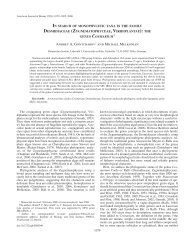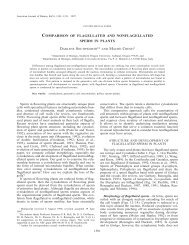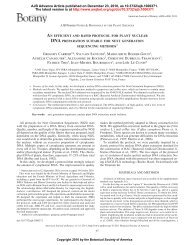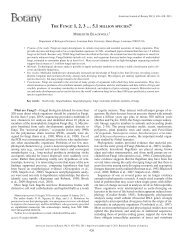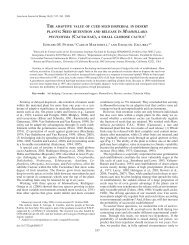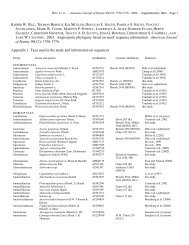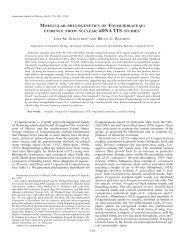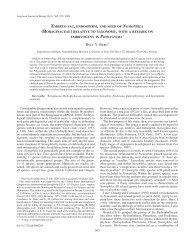View - American Journal of Botany
View - American Journal of Botany
View - American Journal of Botany
You also want an ePaper? Increase the reach of your titles
YUMPU automatically turns print PDFs into web optimized ePapers that Google loves.
September 1999] KRON ET AL.—PHYLOGENETICS OF ANDROMEDEAE<br />
1291<br />
sue; testa cells variable in shape, but <strong>of</strong>ten about as broad<br />
as long and distinctly thickened; <strong>of</strong>ten paracytic stomata;<br />
unlignified cells in the phloem not occurring in bands;<br />
and chromosome base numbers <strong>of</strong> x 11, 12, 13, and<br />
18.<br />
Monophyly <strong>of</strong> the Andromedeae has never been rigorously<br />
assessed. Therefore, in this paper, we focus on<br />
the question <strong>of</strong> the group’s monophyly and its appropriate<br />
circumscription. In addition, we investigate here the<br />
monophyly <strong>of</strong> both the Lyonia group and the Gaultheria<br />
group. The monophyly <strong>of</strong> the Gaultheria group has never<br />
been investigated, while the monophyly <strong>of</strong> the Lyonia<br />
group has been considered only in a preliminary fashion<br />
(Judd, 1979; Kron and Judd, 1997). Selected members <strong>of</strong><br />
the Vaccinieae and Epacridoideae are included in these<br />
cladistic analyses because <strong>of</strong> previous analyses that indicated<br />
a close relationship to members <strong>of</strong> the Andromedeae<br />
(Anderberg, 1993; Kron and Chase, 1993; Kron,<br />
1996, 1997; Kron et al., 1998).<br />
Ericaceae show a great deal <strong>of</strong> morphological variability<br />
and have been well studied from the standpoint <strong>of</strong><br />
morphology, anatomy, embryology, and secondary chemistry<br />
(Niedenzu, 1890; Artopoeus, 1903; Samuelsson,<br />
1913; Matthews and Knox, 1926; Cox, 1948; Palser,<br />
1951, 1952, 1954, 1958, 1961a, b; Chou, 1952; Copeland,<br />
1954; Safijowska, 1960; Paterson, 1961; Wood,<br />
1961; Lems, 1962, 1964; Watson, 1962, 1965; Leins,<br />
1964; Towers, Tse, and Maas, 1966; Harborne, 1969; Stevens,<br />
1969, 1970a, b, 1971; Harborne and Williams,<br />
1973; Villamil and Palser, 1981; Vander Kloet, 1983,<br />
1988; Baas, 1985; Rao and Chakraborti, 1985; Middleton<br />
and Wilcock, 1990a, b; Middleton, 1991a; Odell and<br />
Vander Kloet, 1991; Anderberg, 1994; Powell et al.,<br />
1997). In addition, many <strong>of</strong> the genera considered here<br />
have been recently monographed or are part <strong>of</strong> recent<br />
floristic treatments (Sleumer, 1959, 1966, 1967; Hersey<br />
and Vander Kloet, 1976; Dorr, 1980; Melvin, 1980; Judd,<br />
1981, 1982, 1984, 1986, 1990, 1995a, b, c; Judd and<br />
Hermann, 1990; Luteyn, 1991, 1995a, b, c, 1996; Middleton,<br />
1991b; Luteyn et al., 1996), and their general phylogenetic<br />
placement within the Ericaceae can be assessed<br />
by reference to several higher level phylogenetic analyses<br />
that use morphology (Anderberg, 1993; Judd and Kron,<br />
1993; Kron and Judd, 1997) and rbcL, matK, and nr18s<br />
sequence data (Kron and Chase, 1993; Kron, 1996, 1997,<br />
and unpublished data; Kron and King, 1996; Kron and<br />
Judd, 1997; Kron et al., 1999).<br />
Current studies by Kron (Kron, 1997; Kron and Judd,<br />
1997, and work in progress) indicate that matK is an appropriate<br />
gene to use for phylogenetic analysis in Ericaceae<br />
s.l. (sensu lato). Our knowledge <strong>of</strong> morphological<br />
and molecular variation within the Andromedeae certainly<br />
is now sufficient to undertake phylogenetic analyses<br />
<strong>of</strong> this group, and numerous recent studies have demonstrated<br />
the effectiveness <strong>of</strong> combined analyses <strong>of</strong> phenotypic<br />
and molecular data.<br />
MATERIALS AND METHODS<br />
Representatives <strong>of</strong> all 13 genera <strong>of</strong> Andromedeae were sampled for<br />
this study. Twenty-eight taxa were sampled for the phenotypic cladistic<br />
analyses, while 29 taxa were included in the molecular analyses (Table<br />
1). This study specifically tested the monophyly <strong>of</strong> the tribe Andro-<br />
TABLE 1. Ericalean species included in cladistic analyses <strong>of</strong> the Andromedeae.<br />
All species were used in both morphological and molecular<br />
analyses except Harrimanella hypnoides (see text); Gen-<br />
Bank accession numbers are in brackets. a All species were traditionally<br />
placed in Andromedeae unless otherwise indicated.<br />
Enkianthus campanulatus (Miq.) Nichols—outgroup [matK, GBAN-<br />
U61344; rbcL, GBAN-L12616]<br />
Harrimanella hypnoides (L.) Cov.—outgroup [matK, GBAN-U61315:<br />
rbcL, GBAN-U82766]<br />
Sprengelia incarnata Smith—as representative the epacrid clade, and<br />
as outgroup [matK, GBAN-AF015645; rbcL, GBAN-80421]<br />
Prionotes cerinthoides R. Br.—as representative <strong>of</strong> the epacrid clade,<br />
and as outgroup [matK, GBAN-AF015642; rbcL, GBAN-U79743]<br />
Agarista populifolia (Lam.) Judd [matK, GBAN-U61306; rbcL,<br />
GBAN-AF124589]<br />
Agarista salicifolia (Comm. ex Lam.) G. Don [matK, GBAN-U61313;<br />
rbcL, GBAN-AF124588]<br />
Andromeda polifolia L. [matK, GBAN-AF124569; rbcL, GBAN-<br />
AF124572]<br />
Chamaedaphne calyculata (L.) Moench. [matK, GBAN-AF015630;<br />
rbcL, GBAN-L12606]<br />
Craibiodendron yunnanense W. W. Smith [matK, GBAN-U61307;<br />
rbcL, GBAN-AF124589]<br />
Diplycosia acuminata Becc. [matK, GBAN-AF124563; rbcL, GBAN-<br />
AF124586]<br />
Gaultheria miqueliana Takeda [matK, GBAN-AF124567; rbcL,<br />
GBAN-AF124590]<br />
Gaultheria shallon Pursh [matK, GBAN-AF124565; rbcL, GBAN-<br />
AF124574]<br />
Pernettya tasmanica J.D. Hooker [matK, GBAN-AF124568; rbcL,<br />
GBAN-U82765]<br />
Leucothoë racemosa (L.) Gray [matK, GBAN-AF124564; rbcL,<br />
GBAN-U83915]<br />
Leucothoë fontanesiana (Steudel) Sleumer [matK, GBAN-AF124570;<br />
rbcL, GBAN-AF124585]<br />
Lyonia ligustrina (L.) DC. [matK, GBAN-U61311; rbcL, GBAN-<br />
AF124578]<br />
Lyonia ferruginea (Walter) Nutt. [matK, GBAN-U61312; rbcL,<br />
GBAN-AF124584]<br />
Lyonia lucida (Lam.) K. Koch [matK, GBAN-U61308; rbcL, GBAN-<br />
U82764]<br />
Lyonia ovalifolia (Wallich) Drude ([matK, GBAN-U61305; rbcL,<br />
GBAN-AF124580]<br />
Oxydendrum arboreum (L.) DC. [matK, GBAN-AF124562; rbcL,<br />
GBAN-AF124583]<br />
Pieris phillyreifolia (W.J. Hooker) DC. [matK, GBAN-U61309; rbcL,<br />
GBAN-AF124573]<br />
Pieris floribunda (Pursh) Bentham and Hooker [matK, GBAN-<br />
U61304; rbcL, GBAN-AF124577]<br />
Pieris formosa (Wallich) D. Don [matK, GBAN-U61303; rbcL,<br />
GBAN-AF124581]<br />
Pieris nana (Maxim.) Makino [matK, GBAN-U61310; rbcL, GBAN-<br />
AF124582]<br />
Satyria warszewiczii Klotzsch [matK, GBAN-U61314; rbcL, GBAN-<br />
AF124579]<br />
Tepuia cardonae A. C. Smith [matK, GBAN-AF124566; rbcL,<br />
GBAN-AF124575]<br />
Vaccinium macrocarpon Aiton [matK, GBAN-U61316; rbcL, GBAN-<br />
L12625]<br />
Vaccinium meridionale Sw. [matK, GBAN-U89759; rbcL, GBAN-<br />
AF124576]<br />
Zenobia pulverulenta (Bartram ex Willd.) Pollard [matK, GBAN-<br />
AF124571; rbcL, GBAN-L12626]<br />
a The prefix GBAN- has been added for linking the online version <strong>of</strong><br />
<strong>American</strong> <strong>Journal</strong> <strong>of</strong> <strong>Botany</strong> to GenBank but is not part <strong>of</strong> the actual<br />
GenBank accession number.



